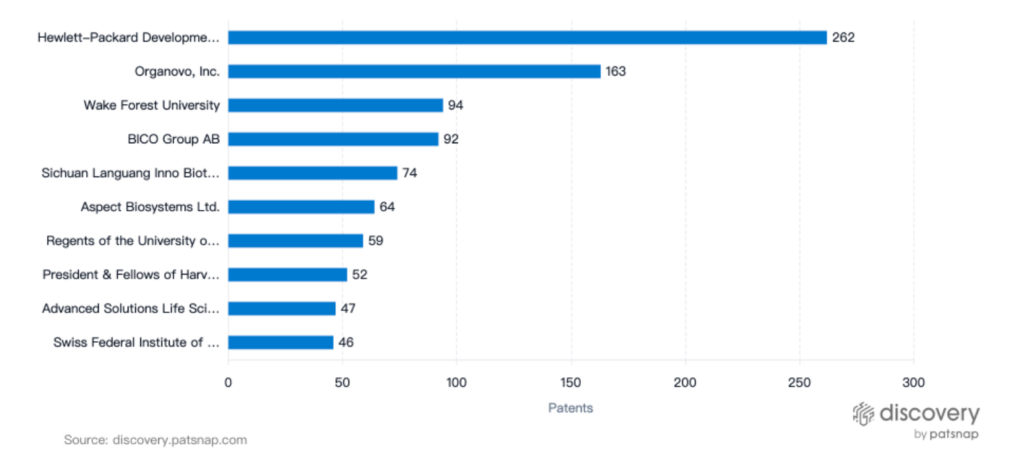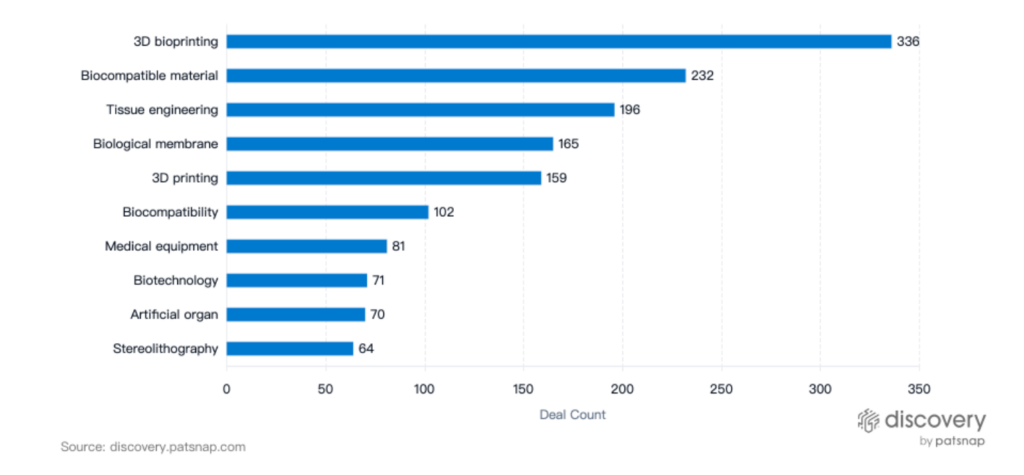Bioprinting Innovative Advancements: Tissue Engineering
Bioprinting is a revolutionary technology that has the potential to transform tissue engineering and regenerative medicine. Using 3D printing technology, scientists can create complex structures and shapes with living cells and biomaterials.
In this article, we’ll explore some of the latest advancements in bioprinting that are changing the face of tissue engineering.
Let’s dive in!

As the PatSnap Discovery chart above illustrates, the bioprinting technology space is dominated by a few key players in terms of patent filings. Hewlett-Packard takes the lead with nearly 300 patents for bioprinting, followed by Organovo, Inc, and Wake Forest University.
1.) Multi-Cellular Bioprinting
One of the most exciting advancements in bioprinting is the ability to print tissues and organs with multiple cell types. This means that scientists can create more complex structures that better mimic the natural tissues of the body. For example, a team of researchers at the University of California, Berkeley recently developed a 3D printer that can create human organs with blood vessels.
2.) Decellularization
Decellularization is a process that removes cells from an organ or tissue, leaving behind the extracellular matrix (ECM). This ECM can then be used as a scaffold for new cells to grow on. By using decellularized tissues and organs, scientists can create functional replacements for damaged or diseased tissues. This technique has been used to create functional bladders, blood vessels, and even hearts.
3.) Bioinks
Bioinks are materials that are used to create 3D structures with living cells. These materials must be biocompatible and provide a suitable environment for cell growth and differentiation. Researchers are developing new bioinks that can mimic the properties of natural tissues, such as stiffness, elasticity, and porosity. These bioinks can be used to create complex structures with multiple cell types.
4.) Vascularization
Vascularization is the process of creating blood vessels within a tissue or organ. Without a vascular system, cells cannot receive the oxygen and nutrients they need to survive. Bioprinting has enabled researchers to create vascularized tissues and organs, which could be used to replace damaged or diseased tissues. For example, researchers at Harvard University have developed a method for printing functional blood vessels.
5.) Skin Bioprinting
One of the most promising applications of bioprinting is in the field of skin regeneration. Researchers are developing bioprinted skin substitutes that can be used to treat burns and other skin injuries. These substitutes are made from living cells and biomaterials and can be customized to match the patient’s skin type and color.

Venture capital is playing a significant role in driving innovation in bioprinting, and investors are closely monitoring the most promising industries in this field. It’s crucial to understand where the highest capital is being invested to make informed investment decisions in this novel and rapidly growing industry.
As the chart above illustrates, biocompatible materials and tissue engineering are emerging as the most VC-backed industries in the bioprinting space. Investing in these areas can potentially lead to higher returns on investment as they are poised to revolutionize the way we approach tissue regeneration and medical treatment. By keeping an eye on these promising industries, investors can position themselves to capitalize on the latest developments in bioprinting technology.
Conclusion
In conclusion, bioprinting is a rapidly advancing field that has the potential to revolutionize tissue engineering and regenerative medicine. From multi-cellular bioprinting to skin regeneration, these advancements are opening up new possibilities for the treatment of a wide range of diseases and injuries.
As we continue to explore new applications of bioprinting, it is clear that this technology will play a critical role in shaping the future of healthcare. By embracing these advancements and incorporating them into medical practice, we can look forward to a new era of tissue engineering and regenerative medicine.